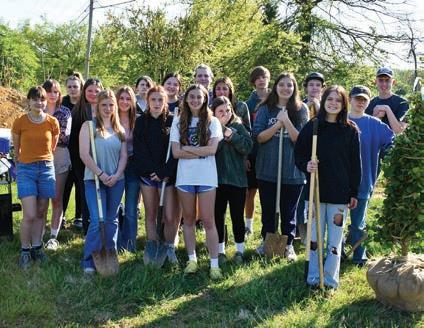
2 minute read
Saluting A Habitat Tree
By Doug Pifer
It’s good for a tree’s overall health to remove dead branches. And falling limbs can be a true hazard. But there is great value in keeping a dead tree standing in a safe spot in your yard or property.
Advertisement

My wife and I were thrilled to discover a big Kentucky Coffee tree growing next to our driveway when we moved here. As it began to leaf out, we sadly learned it was near the end of its life. Several large limbs had already fallen, and one of them had damaged the roof of the garden shed. We were concerned that, during a storm, more falling limbs would damage our newly built fence or our car.
We wanted our tree to remain standing as wildlife habitat so we had arborists from Viking Tree Service carefully sculpt it so the limbs couldn’t fall and cause damage. Now the old Kentucky coffee tree stands majestically like a dead tree in the woods.
This old tree was a wildlife habitat long before we moved here. For trees, death can be very gradual. A dying tree, which foresters call a hard snag, attracts woodboring insects, lichens, moss, and fungi. Weather and wind work to soften the outer bark and it starts to slough away, leaving open spaces where bats roost during the day. Woodpeckers chisel into the tree to get the ants, beetles, and other insects hidden in chambers and networks of tunnels in the dead wood.
After several years, fibers in the dead wood gradually soften and continue to break down, and the dead tree becomes a “soft snag” in forestry-speak. Woodpeckers that used to hunt the hard snag for insects now chop away deep cavities for nesting. After the woodpeckers raise a brood, they abandon the nest hole, preferring to dig out a new one next season. The empty woodpecker cavities shelter rodents, snakes and lizards.
These ”secondary” tree cavities are prime real estate for nesting birds in the spring. Chickadees, titmice, flycatchers, barred and screech owls, bluebirds and wood ducks all nest in abandoned woodpecker holes. Certain cavity nesters, like owls, add no further nest material. Others, like wrens and chickadees, fill the chamber with sticks, grass, or moss. Some cavity nesters add plastic or paper wrappers, shed snake skins, or feathers.
Bluebirds and purple martins are native birds that once nested in old woodpecker holes. But since the 19th century European starlings aggressively took over nesting sites to the extent that the native birds’ populations began to suffer. Nowadays bluebirds and purple martins are on the rebound, largely because they have come to prefer nesting in manmade bird boxes instead of using “traditional” sites.
Dead trees also make wonderful loafing sites. Birds like to hang out where they can see approaching enemies. They rest, preen, and socialize without leaves and branches getting in the way. They can quickly dry after a rain and warm themselves in the sunshine. Here at our place a great blue heron often perches atop a big dead hackberry tree next to the stream at the corner of our property. Vultures sometimes roost there, lingering on into the morning until the sun warms and dries their feathers.
Our colony of purple martins used to loaf in our old Kentucky coffee tree top during the day. Their newly fledged young assembled there and were fed insects by their parents.
For several years the very first male martin to arrive perched on this same treetop. Now the upper branches have disappeared. Our martins hang out elsewhere.
Even a healthy tree left to its own devices continues to drop dead limbs and branches throughout its life. Such fallen limbs teem with wood lice, ground beetles, centipedes, and slugs. Salamanders burrow underneath. The rotting wood becomes entangled by white, thread-like mycelia from mushrooms and other fungi as the remains gradually molder into the forest floor.
Witnessing our old tree’s decline offers me a new perspective on life, death and change.








